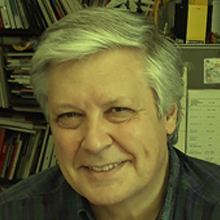Tengo la suerte y el honor de ver que siguen aceptando la invitación de hacer este vis a vis, humoristas gráficos de gran calidad artística, de un tremendo nivel internacional. En esta ocasión tenemos la presencia de un grande de Italia, de Europa y del mundo. Me refiero al dibujante humorístico Marco De Angelis. Un creador de enorme talento y una persona amable, amistosa, acogedora. Un humorista gráfico que ha obtenido ¡150 premios en concursos internacionales!, en múltiples países.
PP: Hola, Marco. Feliz de poder dialogar contigo. Te confieso que traté de impresionar a nuestros lectores en la introducción, resaltando tus premios, etcétera. Pero pienso que me quedé corto. Por favor, ¿podrías presentarte tú mismo para que los seguidores de Humor Sapiens te conozcan mejor?
MARCO: Nací en Roma, la ciudad donde siempre he vivido, aunque he tenido relaciones laborales con muchos otros países. Soy humorista, ilustrador, periodista profesional y diseñador gráfico. Mi actividad como dibujante comenzó oficialmente en 1972, cuando tenía 17 años y expuse por primera vez en una exposición internacional, el Salón Internacional del Humor de Bordighera. Luego seguí dibujando y colaborando con varios periódicos durante mis estudios universitarios, hasta compaginar mi trabajo como diseñador satírico e ilustrador con el de periodista en las redacciones de importantes diarios: primero Il Popolo, luego Il Messaggero y La Repubblica. Esto además de tener, a lo largo de 50 años, muchas colaboraciones con otros periódicos en Italia, en los EE. UU. (a través de varios sindicatos) y en otros países, con las más importantes editoriales para niños y también trabajando como gráfico publicitario, editor y diseñador. Ahora como periodista estoy jubilado y, aparte de algún artículo de vez en cuando, me dedico exclusivamente al dibujo.
PP: ¿Te gustan que te hagan entrevistas?
MARCO: Siempre me siento un poco avergonzado de destacarme a mí mismo, pero también disfruto hablar sobre mi trabajo y mis experiencias, mi estilo y mis elecciones. Además de darme a conocer de una manera más profunda, puede ser de utilidad para muchos jóvenes autores que quieran seguir una carrera como ilustradores.
PP: Ya que mencionas “jóvenes autores”, te pregunto: ¿cómo te hiciste humorista gráfico? ¿Hubo un momento exacto, mágico? ¿O fue un proceso?
MARCO: Me encanta dibujar desde que tenía tres años, encontrando un gran apoyo en mis padres (amantes del arte y dotados de sentido del humor) y he tratado de perfeccionarme desde el principio, estudiando de forma independiente cómo dibujaban los autores de historietas y cómo se comunicaban. Me gustaron más, profundizando en los estilos y entendiendo su filosofía. Lo que luego aprendí en la escuela, tanto en la técnica como en el estudio de la Historia del Arte (asistí al Liceo Scientifico y a algunos cursos de dibujo en vivo), luego me enriqueció: lamentablemente cuando era joven no había escuelas de cómic, ilustración o de gráficos que me podrían ayudar, como es el caso de hoy. Por lo tanto, descubrí el humor de niño a través de los cómics de Walt Disney, el brillante ilustrador italiano Jacovitti, la bande-dessinée de la escuela franco-belga y luego los grandes autores europeos de historietas humorísticas y satíricas, a quienes conocí de niño a través de los periódicos. y luego asistiendo a exposiciones internacionales. Además, en Italia era muy difícil vivir del dibujo y la mayoría de los autores también tenían otros trabajos más seguros. Pero lo que en un principio nació como una pasión, el principal hobby entre los muchos que tenía, se convirtió imprevisiblemente en una verdadera profesión cuando me contrataron como periodista e ilustrador oficial de Il Popolo a los veinticinco años. En ese momento mi vida tomó su rumbo definitivo con el viento propicio.
PP: Según tu experiencia personal entonces, ¿piensas que el humorista nace o se hace?
MARCO: Creo que el humor está en el ADN, pero se puede desarrollar en diversos grados según el contexto en el que vivimos o la cultura que nos rodea. En muchas personas permanece latente o atenuada, muchas no tienen sentido del humor (y les tengo lástima...), un estado de ánimo que realmente no les pertenece o que consideran poco digno y equilibrado. Muchas personas tienen trabajos muy serios, pero aún desarrollan dentro de sí mismos un gusto por la ironía.
En mi caso, el humor lo llevo desde niño, se ha ido enriqueciendo y perfeccionando, se ha convertido en una filosofía de vida e incluso en una profesión. Tomó varios matices, permaneciendo siempre conmigo como un salvavidas a lo largo de mi vida. A veces me ayudaba a calmar situaciones, otras veces a ayudarme en las dificultades, solo o compartiéndolo con otros para sonreír juntos.
PP: Tal cual dices, el humor es muy abarcador, importante y necesario en esta vida. Yo también les tengo lástima a los agelastos. Incluso hay personas que no solo rechazan el humor y la risa, sino que disfrutan morbosamente la tragedia y el drama. Sobre eso y pensando en los creadores: ¿crees que es más fácil hacer llorar que hacer reír, como piensan muchos colegas?
MARCO: Yo también lo creo, de hecho el llanto está ligado a sentimientos y sensaciones primarias, como la emoción o el dolor. Cuando nace un bebé, llora en lugar de reír. La risa es el resultado de un mecanismo mental, que puede ser espontáneo o resultado del razonamiento, pero que implica la capacidad de crear o encontrar el aspecto irónico, cómico, paradójico, surrealista de una situación. Más difícil aún es cuando el humor se fusiona con el comentario periodístico, como debe considerarse la sátira, en la que se expresa un mensaje complejo a través de una metáfora gráfica o un chiste, en el que la síntesis y la eficacia son esenciales.
PP: ¿Y desde que comenzaste pensaste así? Es decir, ¿en tu caso ha variado, ha evolucionado, su forma de hacer humor desde sus inicios hasta este momento?
MARCO: Ha habido una pequeña evolución a lo largo de los años, pero no radical, y esto se debe principalmente a la experiencia profesional, que me ha llevado a adaptar mi estilo según las distintas publicaciones y los diferentes públicos, tanto en la sátira como en la ilustración infantil, en la técnica como en contenido. ¡Obviamente el mensaje es muy diferente si va dirigido a un niño o a un adulto!
También en la técnica antes usaba mucho más el blanco y negro y ahora prefiero el color, pero esto depende de la evolución de la impresión en los productos editoriales y de los pedidos de las editoriales.
Lo que descubrí de inmediato, y que siempre ha sido la pauta de mi humor, es que toda idea y todo comentario gráfico (incluso en su realización artística) debe llegar inmediatamente al corazón y a la mente del lector, con un concepto conciso e inmediato. Siempre he utilizado el humor sin palabras (salvo en contadas ocasiones en que el texto era indispensable o funcional) y siempre he preferido la metáfora gráfica, el simbolismo, los juegos de paradojas o las situaciones surrealistas. Esta elección mía fue ciertamente desafiante, pero me permitió tener siempre una relación de entendimiento directo con el público internacional.
PP: ¿Tienes influencias de colegas italianos vivos o muertos?
MARCO: Seguro que de niño me encantaba Benito Jacoviti, un gran dibujante con un humor surrealista y un estilo muy personal. Pero luego también admiré después a humoristas como Isidori, Botter, Cavallo y otros grandes maestros de la sátira del pasado, como Galantara y Scalarini. También dibujantes como Scarpa, Nidasio, Bottaro* o Cimpellin. Pero siempre cuidadosamente evitando dejarme influenciar por ellos, sin imitarlos gráficamente, buscando mi propia singularidad, pero estudiando los diferentes mecanismos creativos de su humor.
*(Botter y Bottaro son dos autores diferentes)
PP: ¿Cuáles humoristas gráficos a nivel mundial, vivos o muertos, te gustan más?
MARCO: No hablo de autores vivos, aunque haya algunos notables, pero entre los difuntos pienso en autores como Quino y Mordillo, de cuya amistad recuerdo, Sempé, Steinberg, Bosc, Chaval, Bretecher, Serre, con su capacidad para hacer sonreír y pensar, cada uno a su manera y con diferentes estilos, que van desde el humor puro al humor satírico, desde la investigación psicológica a la comedia. También en el campo del cómic no puedo olvidar a autores como Carl Barks, Morris, Uderzo, Peyo.
PP: ¿Te sientes feliz y realizado con tu carrera en el humor, con tantísimos premios? ¿Qué sientes saber que eres uno de los más grandes humoristas gráficos de Italia de todos los tiempos? (No se trata de que me respondas con soberbia o autosuficiencia, pero tampoco me gustaría que fueras muy modesto).
MARCO: Puedo estar satisfecho con la cantidad y calidad del trabajo realizado hasta ahora, las numerosas y diversificadas colaboraciones, las muchas metas alcanzadas y los éxitos obtenidos. Los numerosos premios recibidos en los distintos concursos y exposiciones han supuesto sin duda importantes reconocimientos profesionales (la Palma de Oro en el Salón Bordighera del 97, dos premios del Consejo de Europa o los Primeros Premios recibidos en el Aydin Dogan Vakfi, además de todos los otros...), a veces incluso con desarrollos laborales. Pero al mismo tiempo siempre me parece que todavía tengo mucho más por hacer (y de hecho lo tengo) y constantemente pienso en muchos proyectos y oportunidades aún en el cajón.
Sinceramente, no creo que sea uno de los mejores dibujantes italianos de historietas de todos los tiempos (no uso la palabra dibujante, porque en Italia dibujante es sobre todo aquellos que crean cómics con historias o tiras), pero ahora mismo soy uno de los más apreciados y conocidos en todo el mundo. Esto ya es una gran satisfacción y un resultado muy gratificante.
PP: Si según tú mismo eres “uno de los más apreciados y conocidos en todo el mundo”, para mí significa que estás en la historia del humor gráfico italiano. Por lo tanto, eres uno de los mejores de todos los tiempos. Ya sé que no es fácil aceptarlo por modestia y eso habla bien de ti, pero es una verdad lo aceptes o no. Pero sigamos con tu trabajo. Te has especializado en viñetas editoriales, en la sátira política y social. Pero, ¿has incursionado en el humor general, el llamado “humor blanco”, aunque también haga pensar? ¿O en la caricatura personal? ¿O en la tira cómica o en la historieta humorística? Y si lo has hecho, entonces prefieres, evidentemente, la sátira, ¿es así o ando equivocado?
MARCO: En realidad me especialicé en la sátira casi obligada por la evolución de mi trabajo, ya que comencé a publicar cada día en los periódicos un dibujo satírico, creado en un tiempo récord, mientras también realizaba la labor editorial, en el servicio gráfico o como autor de artículos de política interior o exterior: era una carrera diaria con el tiempo y con las ideas, lo cual no era fácil con mi estilo siempre certero, en tiempos en que no había computadora... Todo eso me hizo rápido y entrenado, incluso en las ilustraciones que hice para las páginas culturales, que son muy útiles incluso ahora. Fue precisamente mi formación periodística, que me lleva a observar, estudiar y comentar hechos, lo que me influyó mucho en la sátira política y social.
Sin embargo, a veces también me gusta dedicarme al humor "blanco", al humor puro, a los gags; me divierte, pero sobre todo si apunta siempre a mirar al ser humano y al mundo.
También me he dedicado mucho a la ilustración infantil y juvenil, lo que me divierte mucho y me aleja de la actualidad estrictamente (por la que de vez en cuando me dan náuseas), dándome una verdadera sensación de frescura.
Mucho menos me moví hacia los cómics, aunque mi primera obra publicada en un periódico, en 1975, fue una historieta breve de humor, y también publiqué tiras cómicas más tarde. Pero no me importaría hacer algo en el futuro.
PP: Y ahora, ¿podrías contar una anécdota ya sea graciosa, o ingeniosa, o curiosa, que hayas vivido dentro de tu carrera en el humor?
MARCO: Tendría muchas, pero me gusta recordar una viñeta publicada en el diario Il Popolo, pocos días después de mi contratación, aún en período de prueba, en 1980. Era un momento delicado antes de las elecciones con un acercamiento del Partido Comunista y Christian Democracia, editor de la revista my. Retraté al secretario comunista Berlinguer que esperaba, ya anciano, en una antesala a que la DC le abriera la puerta. Al día siguiente fue duramente criticada por el diario PCI, citada en varios diarios y en los noticieros, luego se le hizo una pregunta al secretario del PCI, Berlinguer, durante un debate político televisado, cuestionando el naciente encuentro entre los partidos. Como hago todos los días, acudí al director, pero realmente tenía miedo de estar al borde del despido, a pesar de que él lo había aprobado: la política nacional y el futuro del director dependían de mí... Dije “Me parece que hubo algún problema con la caricatura de ayer… um”. Y el director Gilmozzi respondió "Bravo, salió muy bien, sigue así...". ¡Era un gran reportero! Y así aprendí que a veces la política era una cosa, mientras que el periodismo, y especialmente el humor, era otra; por lo tanto, pude seguir con más libertad de lo que pensaba al principio y luego me hice periodista.
PP: Quizás esa época de tu anécdota sea diferente a la de ahora en muchos aspectos. Por ello dime, ¿cómo ves la salud del humor gráfico actualmente? ¿Hay suficientes espacios para publicar? ¿Internet es la solución? ¿Hay suficiente público consumidor?
MARCO: Desafortunadamente, el humor gráfico está sufriendo en Italia y en muchos otros países. En Italia, a pesar de tener una gran tradición de periódicos humorísticos, ya no nos queda casi nada. La mayoría de los diarios ya no tienen viñetas, excepto algunos diarios. Los artistas están mal pagados en comparación con el pasado y los editores eliminan estas colaboraciones primero. Con la revista en línea Buduàr (www.buduar.it) de la que soy editor en jefe y que he estado creando mensualmente durante 12 años con Dino Aloi y Alessandro Prevosto (director y editor), intentamos dar a conocer el humor y la sátira, pero a pesar del gran éxito somos un producto para entusiastas. Internet ha ayudado mucho a la difusión del humor gráfico y ciertamente ha ofrecido a los autores la posibilidad de aparecer y un escaparate internacional antes impensable, pero también ha abierto las puertas a todo el mundo, mezclando alta y baja calidad. Además, el hecho de que cualquiera pueda usar todo lo que aparece en la web sin reglas ha llevado a una constante violación de derechos, a la eliminación de los medios impresos, a la depreciación del trabajo de los dibujantes: un efecto muy grave para quienes lo han hecho de profesión durante toda su vida.
PP: Estoy de acuerdo. Y creo que estamos en una etapa de indefiniciones del tema Internet. Esperemos que se defina mejor. Puede ser la salvación o una catástrofe. Pero seamos optimistas. Y siguiendo en estos tiempos, ¿crees que existe mucha censura en los medios y en la sociedad en general? ¿Mucha autocensura?
MARCO: Depende de los distintos países, por supuesto. Hay países donde la sátira es peligrosa, donde hay límites que no se pueden traspasar y se condena cualquier ironía referida a la política o a la sociedad. Pero incluso en los países más avanzados, donde la democracia y la libertad de expresión están codificadas en las Constituciones, se siente cada vez más el peso de ciertas presiones políticas, protestas o acciones judiciales por parte de grupos económicos, sociales y religiosos. Por no hablar de la censura debida a los temores de los editores sometidos a un políticamente correcto exagerado. La autocensura viene como consecuencia, tanto para evitar problemas en el trabajo como para evitar reacciones histéricas o incluso homicidas por parte de extremistas religiosos.
PP: Tocaste un buen punto, así que debo preguntarte algo “de moda”, ¿cuáles son los límites del humor?
MARCO: Siempre he considerado el humor como neutral y desapasionado (aunque un autor puede tener su propia opinión política) y con el poder de oscilar sin límites entre temas de todo tipo, ya sea por pura ironía o para poder comentar satíricamente la vida que nos rodea. El humor es útil y saludable, nos ayuda a ver a través de las cosas y a superar las emociones. Pero en el campo estrictamente satírico, lamentablemente, hay que tener en cuenta que antes la relación del diseñador era sólo con los lectores de su periódico, mientras que hoy, gracias a los medios y la web, el autor se enfrenta inmediatamente a todo el mundo. También nos enfrentamos a mentalidades, tradiciones, conceptos de libertad y tolerancia diferentes a los nuestros... por no hablar de una ignorancia generalizada y globalizadora, que es la mayor limitación.
PP: Exacto. Lo has resumido muy bien. Pero cambiemos un poco de tema, estimado Marco. Por ejemplo, sabemos que el trabajo ideal del humor gráfico es el que muestra una factura perfecta y un contenido que nos hace sonreír y pensar. Pero a menudo vemos una magnífica idea expresada con una factura pobre y un trabajo impecable en términos de forma, pero con una idea débil. ¿Cuál de estas dos variantes acepta mejor? ¿O ninguna o ellas? ¿Por qué?
MARCO: Para mí la idea y la ejecución deben ser lo más equivalentes posible, pero la idea y el concepto a veces tienen un predominio. Hasta ahora he formado parte de decenas de jurados, pero siempre buscando la mejor creación gráfica, la buena idea siempre ha tenido el peso principal en mi elección. El estilo puede ser elaborado o minimalista, caricaturesco o pictórico, pero sin un buen contenido o un mensaje efectivo, no hay humor. En cualquier caso, siempre busco la habilidad creativa, el dibujo bonito, las señales de que el autor conoce el arte y la técnica, aunque el dibujo sea pobre.
PP: Yo soy de la opinión que aunque la idea sea fundamental, si la forma no tiene calidad, se empaña, se confunde, se daña la idea. Pero ya sabes que todo esto es muy subjetivo. Bueno, para ir terminando, ¿hay alguna pregunta que no te haya hecho y que te hubiera gustado que te hiciera? Si es así, ¿puedes responderla ahora?
MARCO: Me pediste muchas cosas interesantes, pero no me preguntaste si me gustaría hacer otra cosa. En realidad, nunca he podido prescindir del dibujo y el humor, siempre mirando con interés todas las demás formas de arte. Incluso la pasión por la historia, la astronáutica, hobbies varios (siempre modelar, navegar cuando era más joven, y mucho más) nunca lograron distraerme de mi mayor pasión. En otra vida podría ser arqueólogo en lugar de periodista, pero siempre llevaría conmigo un cuaderno de bocetos y encontraría el humor hasta en la tumba etrusca más profunda.
PP: Ja, ja. Un humorista de raza. Gracias por preguntarte y responderte. Y por último, ¿puedes dedicarle unas palabras a nuestros seguidores de humorsapiens.com?
MARCO: Me parece verdaderamente encomiable la atención que esta web presta al mundo del humor y la sátira, a la obra de los autores y a los acontecimientos relacionados con este sector, informando y comentando. El humor, como forma de arte, literatura o periodismo, necesita ser más conocido y defendido porque está en peligro. Hoy puede verse afectado y empobrecido mucho más que en el pasado. Solo conociéndola a fondo podemos entender cuán esencial es para nuestras vidas y para la sociedad.
Muchas gracias por esta entrevista, una linda oportunidad para pensar en el humor y contar brevemente mi historia. Un gran saludo para ti y para los seguidores de humorsapiens.com, recordando no perder nunca la sonrisa y el optimismo.
PP: Estimado Marco, como me lo imaginé, me sentí muy cómodo y agradable en este intercambio contigo. Te agradezco de corazón que hayas aceptado compartir tu tiempo, neuronas y esfuerzo en este vis a vis. Por supuesto, te agradezco también tus generosas palabras sobre Humor Sapiens.
Te deseo mucha salud y que no se detengan tus éxitos, que te llenes aun más de premios, como te mereces. Un abrazo.
(Este texto ha sido traducido al español por Google Translate)
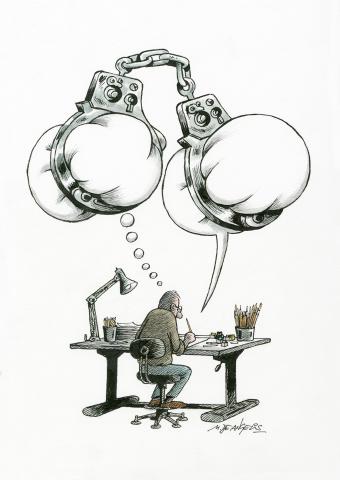
Free cartoons | Marco De Angelis
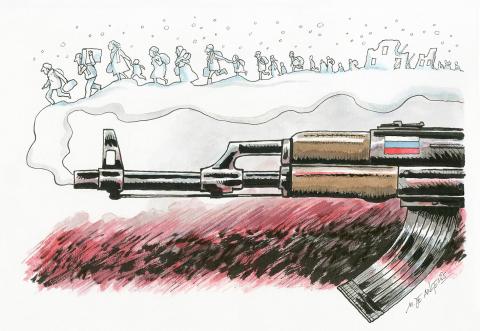
Refugees from Ukraine | Marco De Angelis
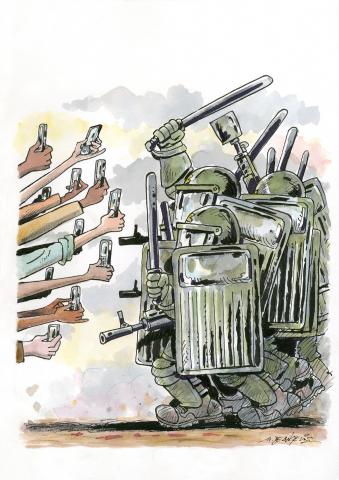
Social media weapon | Marco De Angelis
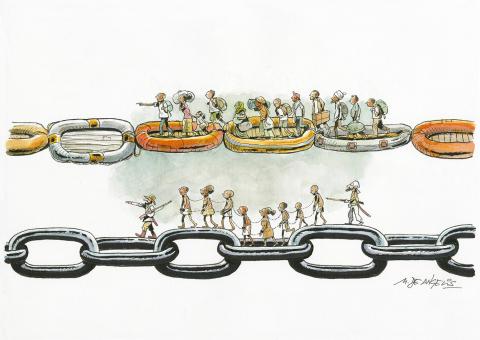
Chains | Marco De Angelis
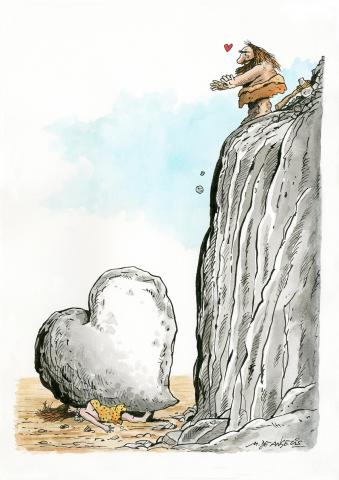
Love of stone | Marco De Angelis
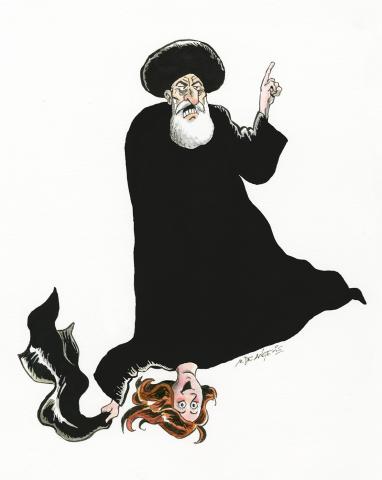
Reverse | Marco De Angelis
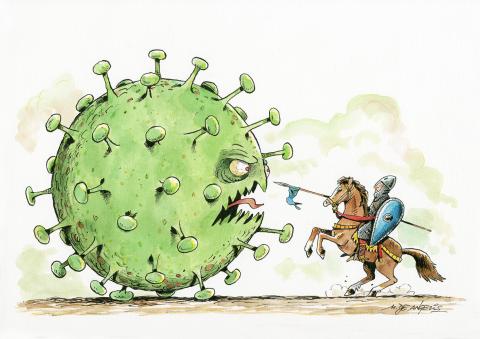
The Dragon | Marco De Angelis
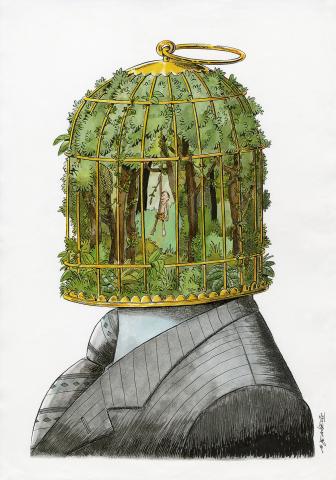
Tarzan in the cage | Marco De Angelis
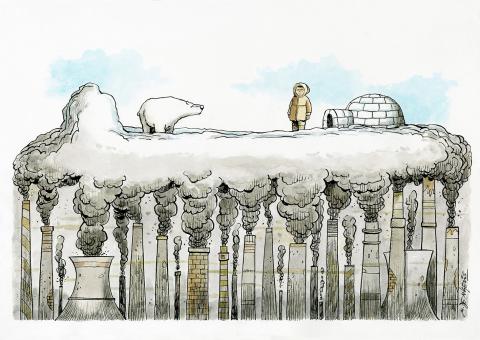
Arctic | Marco De Angelis
Interview with Marco De Angelis
By Pepe Pelayo
Para mí el humor se ha convertido en una filosofía de vida
I am lucky and honored to see that graphic humorists of great artistic quality, of a tremendous international level, continue to accept the invitation to talk here. On this occasion we have the presence of a great from Italy, Europe and the world. I refer to the humorous cartoonist Marco De Angelis. An enormously talented creator and a kind, friendly, welcoming person. A graphic humosita that has obtained 150 prizes in international contests!, in multiple countries.
PP: Hello, Marco. Happy to be able to talk with you. I confess to you that I tried to impress our readers in the introduction, highlighting your awards, etc. But I think I fell short. Please, could you introduce yourself so that the followers of Humor Sapiens get to know you better?
MARCO: I was born in Rome, the city where I have always lived, although I have had working relationships with many other countries. I am a humorist, illustrator, professional journalist and graphic designer. My activity as a cartoonist officially began in 1972, when I was 17 years old and exhibited for the first time at an international exhibition, the Bordighera International Hall of Humor. Then I continued drawing and collaborating with various newspapers during my university studies, until I combined my work as a satirical designer and illustrator with that of a journalist in the newsrooms of important newspapers: first Il Popolo, then Il Messaggero and La Repubblica. This in addition to having, over 50 years, many collaborations with other newspapers in Italy, in the US (through various unions) and in other countries, with the most important publishers for children and also working as a graphic advertiser, editor and designer. Now as a journalist I am retired and, apart from an occasional article, I dedicate myself exclusively to drawing.
PP: Do you like to be interviewed?
MARCO: I always feel a little embarrassed to highlight myself, but I also enjoy talking about my work and my experiences, my style and my choices. In addition to making me known in a deeper way, it can be useful for many young authors who want to pursue a career as an illustrator.
PP: Since you mention “Young authors”, I ask you: how did you become a cartoonist? Was there an exact, magical moment? Or was it a process?
MARCO: I have loved drawing since I was three years old, finding great support in my parents (art lovers and endowed with a sense of humor) and I have tried to improve myself from the beginning, studying independently how comic authors drew and how they communicated. I liked them more, delving into the styles and understanding their philosophy. What I later learned at school, both in technique and in the study of Art History (I attended the Liceo Scientifico and some live drawing courses), later enriched me: unfortunately when I was young there were no schools for comics, illustration or graphics that could help me, as is the case today. Therefore, I discovered humor as a child through Walt Disney comics, the brilliant Italian illustrator Jacovitti, the bande-dessinée of the Franco-Belgian school and then the great European authors of humorous and satirical comics, whom I met from child through the newspapers. and then attending international exhibitions. Also, in Italy it was very difficult to make a living from drawing and most authors also had other, more secure jobs. But what at first began as a passion, the main hobby among the many I had, unexpectedly became a real profession when I was hired as a journalist and official illustrator for Il Popolo at the age of twenty-five. At that moment my life took its final course with the favorable wind.
PP: According to your personal experience then, do you think that the comedian is born or made?
MARCO: I think humor is in the DNA, but it can develop to varying degrees depending on the context in which we live or the culture that surrounds us. In many people it remains latent or attenuated, many do not have a sense of humor (and I pity them...), a state of mind that does not really belong to them or that they consider unworthy and balanced. Many people have very serious jobs, but still develop within themselves a taste for irony.
In my case, humor has been with me since I was a child, it has been enriched and perfected, it has become a philosophy of life and even a profession. It took various nuances, always staying with me like a lifeline throughout my life. Sometimes it helped me to calm situations, other times to help me in difficulties, alone or sharing it with others to smile together.
PP: As you say, humor is very comprehensive, important and necessary in this life. I feel sorry for the agelastos too. There are even people who not only reject humor and laughter, but morbidly enjoy tragedy and drama. About that and thinking about the creators: do you think it's easier to make people cry than make them laugh, as many colleagues think?
MARCO: I think so too, in fact crying is linked to primary feelings and sensations, such as emotion or pain. When a baby is born, it cries instead of laughing. Laughter is the result of a mental mechanism, which can be spontaneous or the result of reasoning, but which implies the ability to create or find the ironic, comic, paradoxical, surreal aspect of a situation. It is even more difficult when humor merges with journalistic commentary, as satire should be considered, in which a complex message is expressed through a graphic metaphor or a joke, in which synthesis and effectiveness are essential.
PP: And since you started did you think like that? That is to say, in your case, has your way of making humor changed, has it evolved from its beginnings up to now?
MARCO: There has been a small evolution over the years, but not radical, and this is mainly due to professional experience, which has led me to adapt my style according to different publications and different audiences, both in satire and in children's illustration, both in technique and in content. Obviously the message is very different if it is addressed to a child or an adult!
Also in the technique before I used black and white a lot more and now I prefer color, but this depends on the evolution of printing on editorial products and on the requests from publishers.
What I immediately discovered, and which has always been the guideline of my humor, is that every idea and graphic comment (even in its artistic realization) must immediately reach the heart and mind of the reader, with a concise and immediate concept. I have always used humor without words (except on rare occasions when the text was essential or functional) and I have always preferred graphic metaphor, symbolism, games of paradoxes or surreal situations. This choice of mine was certainly challenging, but it allowed me to always have a relationship of direct understanding with the international public.
PP: Do you have influences from living or dead Italian colleagues?
MARCO: Surely as a child I loved Benito Jacoviti, a great cartoonist with surreal humor and a very personal style. But later I also admired humorists like Isidori, Botter, Cavallo and other great masters of satire from the past, like Galantara and Scalarini. Also cartoonists like Scarpa, Nidasio, Bottaro* or Cimpellin. But always carefully avoiding letting myself be influenced by them, without imitating them graphically, looking for my own uniqueness, but studying the different creative mechanisms of their humor.
*(Botter and Bottaro are two different authors)
PP: Which worldwide graphic humorists, alive or dead, do you like the most?
MARCO: I am not talking about living authors, although there are some notable ones, but among the deceased I think of authors like Quino and Mordillo, whose friendship I remember, Sempé, Steinberg, Bosc, Chaval, Bretecher, Serre, with their ability to make people smile and think. , each in their own way and with different styles, ranging from pure humor to satirical humor, from psychological investigation to comedy. Also in the field of comics I cannot forget authors like Carl Barks, Morris, Uderzo, Peyo.
PP: Do you feel happy and fulfilled with your career in humor, with so many awards? How does it feel to know that you are one of the greatest Italian cartoonists of all time? (It is not about you answering me with arrogance or self-sufficiency, but I would not like you to be very modest either).
MARCO: I can be satisfied with the quantity and quality of the work done so far, the numerous and diversified collaborations, the many goals achieved and the successes achieved. The numerous prizes received in the different competitions and exhibitions have undoubtedly meant important professional recognitions (the Palme d'Or at the Bordighera Hall of 97, two Council of Europe awards or the First Prizes received at the Aydin Dogan Vakfi, in addition to all the others...), sometimes even with labor developments. But at the same time it always seems to me that I still have a lot more to do (and in fact I do) and I constantly think about many projects and opportunities still in the drawer.
Honestly, I don't think I'm one of the best Italian comic artists of all time (I don't use the word cartoonist, because in Italy cartoonist is mostly those who create comics with stories or strips), but right now I'm one of the most appreciated and known throughout the world. This is already a great satisfaction and a very gratifying result.
PP: If according to yourself you are "one of the most appreciated and well-known in the world", for me it means that you are in the history of Italian graphic humor. Therefore, you are one of the best of all time. I know that it is not easy to accept it out of modesty and that speaks well of you, but it is true whether you accept it or not. But let's get on with your work. You have specialized in editorial cartoons, in political and social satire. But, have you ventured into general humor, the so-called "white humor", even if it also makes you think? Or in the personal cartoon? Or in the comic strip or in the humorous cartoon? And if you have, then obviously you prefer satire, is that right or am I wrong?
MARCO: Actually, I specialized in satire almost forced by the evolution of my work, since I began to publish a satirical drawing every day in the newspapers, created in record time, while also doing editorial work, in the graphic service or as an author of articles on domestic or foreign policy: it was a daily race with time and with ideas, which was not easy with my always accurate style, in times when there was no computer... All of this made me fast and trained , even in the illustrations I did for the cultural pages, which are very useful even now. It was precisely my journalistic training, which leads me to observe, study and comment on facts, that greatly influenced me in political and social satire.
However, sometimes I also like to dedicate myself to "white" humor, to pure humor, to gags; It amuses me, but above all if it always aims to look at the human being and the world.
I have also dedicated a lot to children's and youth illustration, which amuses me a lot and takes me away from strictly current events (which makes me nauseated from time to time), giving me a real feeling of freshness.
Much less did I move towards comics, although my first work published in a newspaper, in 1975, was a short humorous strip, and I also published comic strips later. But I wouldn't mind doing something in the future.
PP: And now, could you tell an anecdote, either funny, or witty, or curious, that you have experienced during your career in humor?
MARCO: I would have many, but I like to remember a cartoon published in the newspaper Il Popolo, a few days after I was hired, still in a trial period, in 1980. It was a delicate moment before the elections with a rapprochement of the Communist Party and Christian Democracy, editor of my magazine. I photographed the communist secretary Berlinguer who was waiting, already an old man, in an anteroom for the DC to open the door for him. The next day it was harshly criticized by the PCI newspaper, quoted in several newspapers and on the news, then a question was put to the PCI secretary, Berlinguer, during a televised political debate, questioning the nascent meeting between the parties. As I do every day, I went to the director, but I was really afraid of being fired, even though he had approved it: the national policy and the future of the director depended on me... I said "It seems to me that there were some problem with yesterday's cartoon… um”. And the director Gilmozzi responded "Bravo, it turned out very well, keep it up...". He was a great reporter! And so I learned that sometimes politics was one thing, while journalism, and especially humor, was another; therefore, I was able to continue with more freedom than I thought at first and then I became a journalist.
PP: Perhaps that time of your acnecdote will be different from now in many aspects. So tell me, how do you see the health of graphic humor today? Are there enough spaces to post? Internet is the solution? Is there enough consumer public?
MARCO: Unfortunately, graphic humor is suffering in Italy and in many other countries. In Italy, despite having a great tradition of humorous newspapers, we have almost nothing left. Most of the newspapers no longer have bullet points, except for some newspapers. Artists are underpaid compared to the past and publishers remove these collaborations first. With the online magazine Buduàr (www.buduar.it) of which I am editor-in-chief and which I have been creating monthly for 12 years with Dino Aloi and Alessandro Prevosto (director and editor), we try to make humor and satire known , but despite the great success we are a product for enthusiasts. The Internet has greatly helped the spread of graphic humor and has certainly offered authors the chance to appear and an international showcase previously unthinkable, but it has also opened the doors to the whole world, mixing high and low quality. In addition, the fact that anyone can use everything that appears on the web without rules has led to a constant violation of rights, the elimination of print media, the depreciation of the work of cartoonists: a very serious effect for those who they have done it by profession all their lives.
PP: I agree. And I think that we are in a stage of indefinitions of the Internet subject. Let's hope it's better defined. It can be salvation or a catastrophe. But let's be optimistic. And continuing in these times, do you think there is a lot of censorship in the media and in society in general? Lots of self-censorship?
MARCO: It depends on the different countries, of course. There are countries where satire is dangerous, where there are limits that cannot be crossed and any irony referring to politics or society is condemned. But even in the most advanced countries, where democracy and freedom of expression are codified in the Constitutions, the weight of certain political pressures, protests or judicial actions on the part of economic, social and religious groups is increasingly being felt. Not to mention censorship due to fears of publishers being subjected to over-the-top political correctness. Self-censorship comes as a consequence, both to avoid problems at work and to avoid hysterical or even homicidal reactions from religious extremists.
PP: You touched on a good point, so I must ask you something “in fashion”, what are the limits of humor?
MARCO: I have always considered humor as neutral and dispassionate (although an author can have his own political opinion) and with the power to oscillate without limits between topics of all kinds, either for pure irony or to be able to satirically comment on the life that lives around us. surrounds. Humor is useful and healthy, it helps us see through things and overcome emotions. But in the strictly satirical field, unfortunately, it must be taken into account that before the designer's relationship was only with the readers of his newspaper, while today, thanks to the media and the web, the author immediately confronts the whole world. . We also face mentalities, traditions, concepts of freedom and tolerance different from ours... not to mention a generalized and globalizing ignorance, which is the greatest limitation.
PP: Exactly. You have summed it up very well. But let's change the subject a bit, dear Marco. For example, we know that the ideal work of graphic humor is the one that shows a perfect invoice and content that makes us smile and think. But often we see a great idea expressed with a poor execution and impeccable work in terms of form, but with a weak idea. Which of these two variants do you accept better? Or none or them? Because?
MARCO: For me the idea and the execution must be as equivalent as possible, but the idea and the concept sometimes have a predominance. Until now I have been part of dozens of juries, but always looking for the best graphic creation, the good idea has always had the main weight in my choice. Style can be elaborate or minimalist, cartoonish or pictorial, but without good content or an effective message, there is no humour. In any case, I always look for the creative ability, the beautiful drawing, the signs that the author knows the art and the technique, even if the drawing is poor.
PP: I am of the opinion that although the idea is fundamental, if the form does not have quality, it becomes blurred, confused, and the idea is damaged. But you know that all this is very subjective. Well, to finish, is there any question that I have not asked you and that you would have liked me to ask you? If so, can you answer it now?
MARCO: You asked me for many interesting things, but you didn't ask me if I would like to do something else. Actually, I have never been able to do without drawing and humor, always looking with interest at all other forms of art. Even the passion for history, astronautics, various hobbies (always modeling, sailing when I was younger, and much more) never managed to distract me from my greatest passion. In another life I might be an archaeologist instead of a journalist, but I would always carry a sketchbook with me and find humor in even the deepest Etruscan tomb.
PP: Ha ha. A comedian of race. Thanks for asking and answering. And finally, can you dedicate a few words to our followers of humorsapiens.com?
MARCO: I find the attention that this website pays to the world of humor and satire, to the work of the authors and to the events related to this sector, informing and commenting truly commendable. Humor, as a form of art, literature or journalism, needs to be better known and defended because it is in danger. Today it can be affected and impoverished much more than in the past. Only knowing it thoroughly can we understand how essential it is for our lives and for society.
Thank you very much for this interview, a nice opportunity to think about humor and briefly tell my story. A big greeting to you and to the followers of humorsapiens.com, remembering never to lose your smile and optimism.
PP: Dear Marco, as I imagined, I felt very comfortable and pleasant in this exchange with you. I sincerely thank you for agreeing to share your time, brain cells, and effort in this dialogue. By. Of course, I also appreciate your generous words about Humor Sapiens.
I wish you good health and that your successes do not stop, that you fill yourself with even more awards, as you deserve. A hug.

